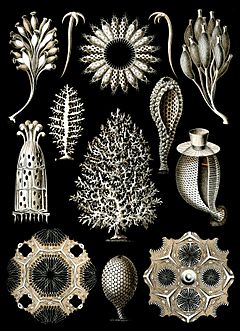Calcareous sponge facts for kids
Quick facts for kids Calcareous sponges |
|
|---|---|
 |
|
| "Calcispongiae" from Ernst Haeckel's Kunstformen der Natur, 1904 | |
| Scientific classification | |
| Kingdom: | |
| Phylum: |
Bowerbank, 1817
|
| Class: |
Calcarea
|
| Orders | |
|
|
Calcareous sponges, also known as Calcarea, are a special group of animals that belong to the phylum Porifera. Think of them as the "cellular sponges" because their bodies are made up of many different kinds of cells working together. What makes these sponges unique is that they have tiny, hard structures called spicules made from calcium carbonate. This is the same material found in seashells!
These sponges are usually quite small. Most of them grow to be about 7 to 10 centimeters (3 to 4 inches) tall. That's about the size of a small smartphone! There are around 15,000 different types of sponges in the world, but only about 400 of them are calcareous sponges. This makes them a smaller, but very interesting, part of the sponge family.
Contents
What Makes Calcareous Sponges Special?
Calcareous sponges are unique because of their spicules. These spicules are like tiny, needle-like crystals that give the sponge its shape and support. They are made of calcium carbonate, which is a strong, chalky substance. These spicules can have different shapes, like three points or four points, and they fit together to form a kind of skeleton for the sponge. This skeleton helps the sponge keep its form and protects it.
How Sponges Get Food
Like all sponges, calcareous sponges are filter feeders. This means they get their food by filtering tiny bits of food from the water. They have many small pores, or holes, all over their bodies. Water flows into these pores and then through a system of canals inside the sponge. Special cells with tiny whip-like tails, called choanocytes, create a current that pulls water in. These cells also trap small food particles, like bacteria and tiny bits of algae, from the water. The cleaned water then leaves the sponge through a larger opening called the osculum.
Where Do They Live?
Calcareous sponges live in oceans all around the world. You can find them in both shallow waters and deeper parts of the ocean. They often attach themselves to rocks, corals, or other hard surfaces on the seafloor. They prefer marine environments, meaning salty ocean water. These sponges play an important role in their ecosystems by filtering water and providing habitats for other small creatures.
Images for kids
See also
 In Spanish: Esponjas calcáreas para niños
In Spanish: Esponjas calcáreas para niños


